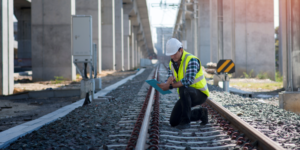
The newly passed federal infrastructure bill is bringing construction spending to the political forefront, and a number of parts of the industry are primed and ready to receive new funding. First up: Amtrak and the Federal Railroad Administration.
It’s been highly touted that the public rail service will receive $66 billion as part of the federal infrastructure bill. Amtrak will be getting $22 billion directly for acquisitions and improvement projects, while the remaining $44 billion will go to the Federal Railroad Administration to be used for state grants and rail projects.
This could have a huge impact on construction work nationwide, as Amtrak CEO Bill Flynn noted that Amtrak would be looking into the expansion of rail service to 160 locations around the country.
Government spending on rail construction in the past has been very significant for individual contractors and joint ventures, meaning larger contractors could see major gains. For example, a 2019 expansion of Seattle’s Sound Transit system awarded more than $1.6 billion in contracts to just two joint ventures.
This would expand the passenger train network to a lot of cities around the country that have been pining for it — like in Louisville, Kentucky, where city leaders have been hoping to revive rail service in the city since its leaving in 2003.
“I think [the infrastructure bill’s passage] is a big boost to increase the likelihood of that happening,” said Kentucky State Senator David Yates. “I think it’s going to draw in new people, new investment opportunities, new jobs and, really, growth.”
Other state leaders noted the importance of the funding in other major construction areas, as well.
“It not only allows Amtrak and the state…to invest in [dealing with] a lot of backlog of repair projects but to start implementing the kind of visionary [planning] work that has been done,” noted former Federal Railroad Administration head Joseph Szabo.
Even with the new funding, city and state leaders know the bidding process for expansion is expected to be competitive.
“As a large metro area, we’ll be one that, I’m sure, will be considered. But it will be very competitive,” said Louisville Mayor Greg Fischer. “I don’t know what our chances are for something like this, but we’ll certainly take a look at it and compete.”
Industry leaders have been careful to stress just how lucrative a lot of this work is going to be, too, and how necessary — contractors should take note that the funding really allows the government to make truly significant investments.
“The price tag has become so high on some of these projects,” said Hani Mahmassani, director of the Northwestern University Transportation Center. “There are so many high-ticket items in there, in terms of bridges and tunnels and so on that you’re just not getting the bang for the buck.”
Even before the process gets going, it’s important for contractors to realize that the prospect of major spending won’t just mean opportunities for easy work and quick payment.
“While it’s true that public projects tend to have more oversight [than private projects do], there are just as many risks (if not more) involved in government projects,” said Levelset’s Tom Scalisi. “Political winds change frequently and budgetary issues are a concern; contractors still face significant risk of payment issues and other headaches on a public job.”
Even in the excitement of such significant spending, it’s important for contractors to keep a close eye on what they need to keep their cash flow moving smoothly and to know what needs to be done in order to guarantee payment on government projects.
“Waiting for your payments isn’t a private-only problem,” Scalisi continued. “You’re equally as likely to run into a payment delay on a taxpayer-funded project as you are on a typical privately-owned project. In fact, in some states, there’s less incentive for a sub to get paid quickly.”
Though nothing is official, people in the industry may already have a good idea of where spending is going to go.
“I would expect a good portion of that $22 billion is probably going to the Northeast Corridor. It makes sense,” noted Pasi Lautala, director of the rail transportation program at Michigan Technological University. “If you want to increase ridership, you need convenience and reliability and right now, I’m not sure if they have either one of them.”
Flynn added that the rail service wasn’t going to let its opportunities stop there, however. “We will continue to work with Congress and the administration to continue to provide necessary funding on an annual basis to make rail a vital transportation option in this country,” he said, noting that there was still work to be done past the additions addressed in the infrastructure bill.